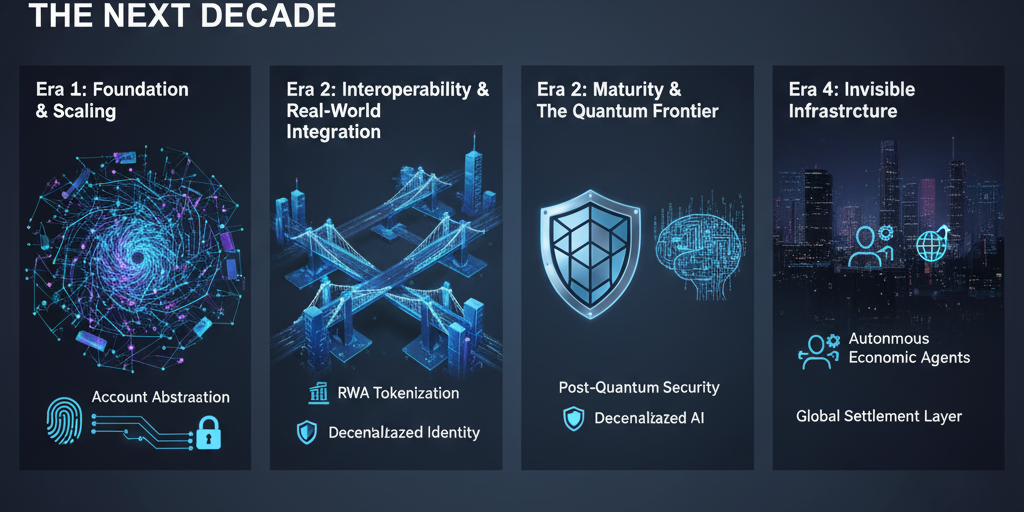The noise of market cycles often obscures the real signal of technological progress. Beyond the price charts and speculative hype, a generation of developers, researchers, and engineers is laying the groundwork for a more decentralized digital future. But what does that future actually look like? Where is this technology headed?
This isn’t a financial prediction; it’s a technologist’s roadmap. It outlines the logical progression of blockchain technology through four distinct eras, from the foundational challenges of today to its eventual place as the invisible backbone of our digital world.
Era 1: The Foundation and Scaling (The Present – 2026)
We are currently in the thick of the most crucial, and perhaps least glamorous, era. The goal is simple but monumental: make blockchains fast, cheap, and usable enough for mainstream applications. The dream of a decentralized world runs on plumbing, and this era is all about building it.
Key Milestones & Technologies:
- Layer 2 (L2) Supremacy: The “scaling wars” are largely being won by rollups. Solutions like ZK-Rollups and Optimistic Rollups are becoming the standard for processing high-volume transactions off the main chain while inheriting its security.
- Modularity vs. Integration: A core architectural debate is in full swing. Will the future be a modular stack (e.g., Ethereum using Celestia for data availability) or a highly-optimized, integrated chain (e.g., Solana)? Both models are being pushed to their limits.
- Account Abstraction (AA): The user experience (UX) is finally getting the attention it needs. AA moves us beyond clunky seed phrases, allowing for social recovery, gas-less transactions, and smart contract-based wallets that feel as seamless as Web2 applications.
Goal of this Era: To solve the scalability trilemma to a point where the network’s capacity is no longer the primary bottleneck for innovation.
Era 2: Interoperability and Real-World Integration (2026 – 2029)
Once individual chains are efficient, the next logical step is to connect them into a seamless “internet of blockchains.” This era focuses on breaking down the isolated ecosystems and bridging the gap between the digital and physical worlds.
Key Milestones & Technologies:
- True Cross-Chain Communication: Moving beyond asset bridges to universal messaging protocols (like Chainlink’s CCIP or LayerZero) that allow complex data and contract calls to move between networks. A dApp on Ethereum will be able to seamlessly use a feature on Solana without the user ever knowing.
- Real-World Asset (RWA) Tokenization: The tokenization of tangible assets—real estate, private equity, carbon credits, treasury bonds—will become a multi-trillion dollar industry. This brings real economic value on-chain, creating new forms of collateral and investment opportunities.
- Decentralized Identity (DID): Verifiable credentials and self-sovereign identity solutions will mature. Your identity—your credentials, reputation, and data—will be a portable asset you control, rather than something fragmented across dozens of corporate servers.
Goal of this Era: To create a fluid, interconnected network of chains and anchor the decentralized economy to tangible, real-world value.
Era 3: Maturity and the Quantum Frontier (2029 – 2032)
With robust, interconnected, and asset-backed networks, the focus will shift to long-term security and exploring entirely new, blockchain-native paradigms. This is where the infrastructure hardens and begins to support applications previously thought impossible.
Key Milestones & Technologies:
- The Post-Quantum Transition: This is a non-negotiable security upgrade for the entire industry. As quantum computers become more powerful, a proactive migration to quantum-resistant cryptographic standards (like those recommended by NIST) will be a critical, network-wide effort to prevent a future cryptographic crisis.
- The Rise of Decentralized AI (DeAI): The convergence of AI and blockchain will unlock powerful new models. This includes everything from on-chain machine learning models that are transparent and tamper-proof to decentralized data markets that allow users to monetize their data for AI training without sacrificing privacy.
- Fully On-Chain Systems: The performance gains from Era 1 will enable truly complex systems like decentralized social media, autonomous worlds, and intricate on-chain games to run without centralized components.
Goal of this Era: To future-proof the security of the ecosystem and begin leveraging its unique properties to build novel, AI-integrated, and truly sovereign systems.
Era 4: Invisible Infrastructure (2032 and Beyond)
The ultimate sign of success for any foundational technology is that it disappears. We don’t think about TCP/IP when we browse the web; we’ll stop thinking about “blockchain” when we use the applications built upon it.
Key Milestones & Technologies:
- Ubiquitous, Unseen Adoption: Users will interact with blockchain-powered systems—for everything from supply chain verification to digital rights management—through simple interfaces without needing to understand the underlying mechanics.
- Autonomous Economic Agents: Decentralized Autonomous Organizations (DAOs) will mature from simple treasuries to complex entities capable of owning and operating real-world assets and businesses with minimal human intervention.
- A Global Settlement Layer: Blockchain networks will serve as a trusted, neutral, and programmable settlement layer for a significant portion of the global economy, from finance to intellectual property.
Goal of this Era: For blockchain to achieve its final form—a universally trusted, globally accessible, and completely invisible utility for digital trust and coordination.



